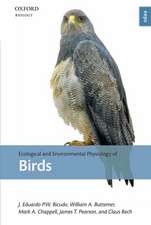Animal Models in Cardiovascular Research
Autor David Grossen Limba Engleză Paperback – 29 oct 2010
| Toate formatele și edițiile | Preț | Express |
|---|---|---|
| Paperback (1) | 952.26 lei 6-8 săpt. | |
| Springer – 29 oct 2010 | 952.26 lei 6-8 săpt. | |
| Hardback (1) | 958.38 lei 6-8 săpt. | |
| Springer – 9 iun 2009 | 958.38 lei 6-8 săpt. |
Preț: 952.26 lei
Preț vechi: 1161.29 lei
-18% Nou
Puncte Express: 1428
Preț estimativ în valută:
182.24€ • 189.56$ • 150.45£
182.24€ • 189.56$ • 150.45£
Carte tipărită la comandă
Livrare economică 14-28 aprilie
Preluare comenzi: 021 569.72.76
Specificații
ISBN-13: 9781441930705
ISBN-10: 1441930701
Pagini: 460
Ilustrații: XXVI, 431 p.
Dimensiuni: 155 x 235 x 24 mm
Greutate: 0.64 kg
Ediția:Softcover reprint of hardcover 3rd ed. 2009
Editura: Springer
Colecția Springer
Locul publicării:New York, NY, United States
ISBN-10: 1441930701
Pagini: 460
Ilustrații: XXVI, 431 p.
Dimensiuni: 155 x 235 x 24 mm
Greutate: 0.64 kg
Ediția:Softcover reprint of hardcover 3rd ed. 2009
Editura: Springer
Colecția Springer
Locul publicării:New York, NY, United States
Public țintă
ResearchCuprins
General Principles of Animal Selection and Normal Physiological Values.- Preanesthesia, Anesthesia, Chemical Restraint, and the Recognition and Treatment of Pain and Distress.- Normal Cardiac Function Parameters.- Measuring Cardiac Function.- Measuring Vascular Function and Ventricular/Arterial Coupling Dynamics.- Isolated Heart Preparations, Problems, and Pitfalls.- Cardiovascular Effects of Anesthetics, Sedatives, Postoperative Analgesic Agents, and Other Pharmaceuticals.- Naturally Occurring and Iatrogenic Animal Models of Valvular, Infectious, and Arrhythmic Cardiovascular Disease.- Iatrogenic Models of Ischemic Heart Disease.- Iatrogenic, Transgenic, and Naturally Occurring Models of Cardiomyopathy and Heart Failure.- Iatrogenic, Congenic, and Transgenic Models of Hypertension.- Naturally Occurring, Iatrogenic and Transgenic Models of Atherosclerotic Disease.- Animal Models for the Study of Neurohumeral and Central Neural Control of the Cardiovascular System.- Other Transgenic Animal Models Used in Cardiovascular Studies.
Notă biografică
Dr. David R. Gross entered private veterinary practice after earning the DVM degree from Colorado State University in 1960. In 1974 he was awarded the PhD degree in physiology from the Ohio State University beginning a 36-year career in academics that culminated as professor and head of the Department of Veterinary Biosciences in the College of Veterinary Medicine, University of Illinois, Urbana-Champaign. Dr. Gross’ research career encompassed 58 funded projects totaling over $5.5 million and 91 papers published in refereed journals using a wide variety of animal models. Ironically his three most-cited research papers received no external funding. He and his colleagues showed that feeding dietary cholesterol to rabbits induced Alzheimer’s-like lesions in the brain. Their work also showed that surgery involving cardiopulmonary bypass resulted in Alzheimer’s-like brain lesions in pigs. With another group of colleagues he helped pioneer minimally invasive coronary artery bypass grafting techniques using the pig as a model.
Textul de pe ultima copertă
Animal Models in Cardiovascular Research covers both historical and recent advances in our understanding of the cardiovascular system from studies conducted in animal models. The last decade has seen an explosion in the use of very specialized congenic and transgenic animal models that were not described in the previous two editions. The results of many of these studies provide a sometime bewildering array of redundant, overlapping and competing molecular pathways demanding further study. This third edition is designed to provide a better basis for understanding and using animal models in the current climate of background knowledge and information.
The first and second editions of Animal Models in Cardiovascular Research emphasized normal cardiovascular parameters and the cardiovascular effects of a wide variety of drugs commonly used for restraint, anesthesia and pain control in the various animal species. The third edition is focused on the avalanche of genetic, molecular and protein-based information generated from the use of both congenic and transgenic animal models. Updated and expanded chapters provide new information generated from classical, congenic and transgenic animal models used to study ischemic heart disease, cardiomyopathy, heart failure, hypertension and atherosclerotic disease.
Completely new chapters in this third edition describe the techniques, problems and pitfalls associated with the measurement of cardiac and vascular function and ventricular/arterial coupling dynamics in various animal models. There is a new chapter detailing problems and pitfalls associated with isolated heart preparations and another describing animal models for the study of neurohumeral and CNS control of the cardiovascular system.
The first and second editions of Animal Models in Cardiovascular Research emphasized normal cardiovascular parameters and the cardiovascular effects of a wide variety of drugs commonly used for restraint, anesthesia and pain control in the various animal species. The third edition is focused on the avalanche of genetic, molecular and protein-based information generated from the use of both congenic and transgenic animal models. Updated and expanded chapters provide new information generated from classical, congenic and transgenic animal models used to study ischemic heart disease, cardiomyopathy, heart failure, hypertension and atherosclerotic disease.
Completely new chapters in this third edition describe the techniques, problems and pitfalls associated with the measurement of cardiac and vascular function and ventricular/arterial coupling dynamics in various animal models. There is a new chapter detailing problems and pitfalls associated with isolated heart preparations and another describing animal models for the study of neurohumeral and CNS control of the cardiovascular system.
Caracteristici
The first two editions of this standard reference text have been cited well over 150 times, according to SCI An expanded first chapter will include more information on the cardiovascular effects of post-operative analgesia Will address the recognition of pain behavior in species commonly used in research settings, particularly rats and mice Includes supplementary material: sn.pub/extras







